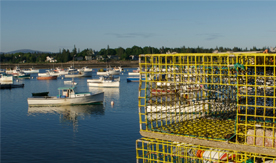Three UMaine Aquaculture Research Projects Receive Funding

A project designed to assess and improve commercial fishermen’s perceptions of aquaculture production is one of three University of Maine Aquaculture Research Institute projects to receive a combined $1.2 million in funding recently from the National Oceanic and Atmospheric Association, Sea Grant and UMaine.
The two other funded research projects will help ARI continue its research in the areas of sea lice management efforts and sea urchin production.
Teresa Johnson, an assistant professor of marine policy in the University of Maine’s School of Marine Sciences, is the principal investigator of the Aquaculture in Shared Waters project. Commercial fishermen face resistance and challenges to becoming aquaculture producers, but factors such as the decreasing profitability of the lobster industry may improve openness to aquaculture production. The project has received a $299,219 grant, plus $160,058 in matching funds.
Johnson and Dana Morse of Maine Sea Grant and University of Maine Cooperative Extension will combine social science research with community research and an applied education plan to understand the attitudes, knowledge and concerns of both the fishing industry and coastal communities. A better understanding of these issues will help increase aquaculture production nationwide and therefore improve the economic prospects of commercial fishermen.
Investigators from UMaine and Maine Sea Grant will identify two groups of commercial fishermen on the Maine coast to engage in an education program in shellfish and seaweed aquaculture. The program will be designed to prepare participants to file applications with the state and begin production operations.
Project partners include the Maine Aquaculture Association, Maine Aquaculture Innovation Center, Coastal Enterprises, Inc., and Island Institute.
UMaine’s Aquaculture Research Institute (ARI) has also received a $461,438 grant from the National Oceanic and Atmospheric Administration (NOAA), with a $236,388 match, to continue sea lice research in collaboration with Cooke Aquaculture.
Ian Bricknell, ARI’s director and a professor in the School of Marine Sciences, will lead the research project that seeks to establish and model where and when sea lice infect migrating or farmed salmon near the shore, and identify potential wild reservoirs of sea lice. The researchers will also investigate the impact of fish farms on the infective pressure of sea lice.
The goal is to provide information to help understand the infectious pressure of sea lice near the coast, the role of wild fish as hosts for sea lice, and sea lice infection dynamics over an aquaculture production cycle. The data gathered will help industry-driven collaborative pest management efforts, and inform lease-granting bodies and marine resource users of sea lice risk factors.
Research will take place in Cobscook Bay, which has a number of active salmon aquaculture operations. Atlantic salmon sentinels, which are used to monitor pathogens in the environment, will be placed at four locations in the bay during an 18-month period to determine the effect of different factors on sea lice infectious pressure. Wild fish in the bay will also be monitored for sea lice infection to establish whether a wild host species exists.
Other investigators include ARI assistant director of research Deborah Bouchard, and Damian Brady and Gayle Zydlewski of the School of Marine Sciences.
The third project to receive funding, which involves researchers in Maine, New Hampshire, Alabama and Texas, will allow researchers to address issues of aquaculture development of sea urchins, both in hatcheries and in sea-based nurseries. The project will be headed up by Nick Brown, director of UMaine’s Center for Cooperative Aquaculture Research (CCAR) in Franklin, Maine.
As stocks of wild sea urchins decline in both the Gulf of Maine and worldwide, the development of green sea urchin aquaculture has the potential to provide a boost to the economy of the Gulf of Maine region. The $51,963 grant will be used to develop cost-effective hatchery and sea-based nursery production of urchins. A team that includes researchers at CCAR will address issues that now hinder the growth of the industry by using both field- and land-based urchin culture systems.
The researchers have a three-stage research plan. In the first stage, they will use two hatchery facilities to develop algal feeding and settlement strategies that maximize larval growth and survival while decreasing costs. In the second phase, the team will use tank-based trials to test variabilities, such as density and diet to promote growth while decreasing variabilities.
In addition, hatchery-reared juvenile urchins from the first stage of the project will be stocked into a field-based nursery system to examine stocking density and site location variables. In the third stage, urchins will be introduced for winter seeding at three lease sites in the Gulf of Maine, where the individuals will be monitored for survival, movement and growth.
Contact: Anne Langston, 207. 356.2982
